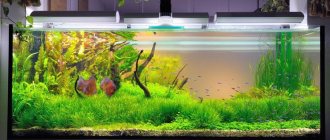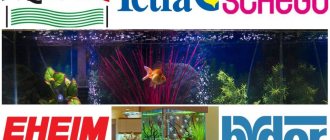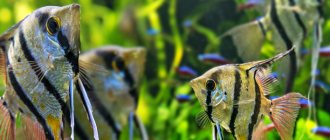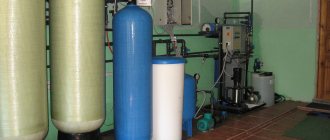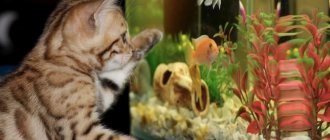Types of tubes and hoses for an aquarium
Based on the material of manufacture, products of this type are:
- Silicone. They are particularly flexible, making it easy to place the tube in the right place and give it the desired shape. Easily cut with ordinary scissors into pieces of the required length.
- Made from PVC (polyvinyl chloride). The material is considered heat-resistant, has increased resistance to chemical attack, and is widely used in aquarium farming. Typically, those owners of artificial reservoirs who need to buy tubes for an aquarium in an online store purchase several meters at once, since such hoses are never superfluous. PVC pipes are usually corrugated and quite flexible.
By purpose they are conditionally divided into:
- hoses for draining dirty water from the aquarium;
- hoses used in conjunction with various devices (filters, pumps, compressors).
Internal filters
Internal filters are distinguished by their simple design, have a low-power water pump and are intended for aquariums with a volume of up to 100 liters. The main purpose of such equipment is to purify aquarium water from suspended matter and other mechanical contaminants. Most models do not even have a compartment for biochemical cleaning; therefore, they are intended for aquariums where water changes are performed on a regular basis.
Internal filters are distinguished by their simple design, have a low-power water pump and are intended for aquariums with a volume of up to 100 liters.
This device is located inside the aquarium and is compact in size. The pump used usually has a performance rating of 300-500 liters per hour. Some modifications have a special air valve for simultaneous aeration and dissolution of oxygen necessary for fish and other aquatic organisms in the water.
The advantages of internal filters include their minimal energy consumption, efficiency of water purification in a small aquarium, affordable cost and ease of installation. Disadvantages include the lack of biochemical purification, as well as the impossibility of using such devices in large aquariums.
Installing the internal filter is not difficult. It is necessary to decide on the location where the cleaning pump will be located. Typically, internal filters are sold disassembled, so it will need to be assembled in accordance with the instructions, while following some recommendations:
- Attach the filter to the suction cup, positioning it so that the upper part is located approximately 3 centimeters deeper than the surface.
- You can only immerse the pump in water after disconnecting it from the electricity.
- The air intake tube is brought outside and additionally secured so that it does not end up under water.
- Plug the pump into the outlet and check for flow, which indicates that the device has been assembled and installed correctly.
You can regulate the power of the pump, and, consequently, the filtration efficiency using a small damper on the outlet pipe. This adjustment is best done with the power turned off.
How much does it cost and how to order?
You can buy aquarium hoses in the online store in various colors: blue, green, black, transparent. When choosing, focus on the purposes for which you are purchasing a hose. So, if it sinks to the bottom of the aquarium, then it is best to take a green or transparent product, since it is easier to disguise it among plants and decorations. It is also good if it has a special UV blocking that prevents green deposits from forming inside. For those who want to buy an aquarium sprayer, the price of silicone hoses is important. It depends on the length of the tube segment in the package, diameter, material of manufacture, packaging. Silicone hoses in a coil are cheaper, corrugated black tubes are more expensive. For the latter, an important criterion when choosing is strength, since the product will be used to remove dirt from the bottom of the aquarium. Keep in mind that the hose (for air or cleaning) must be completely submerged in water, so consider the length of the walls of the container.
In our store you can purchase this product from manufacturers such as Triol, Tetra, Boyu.
You can order aquarium hoses in our online store through the online form or by calling the operator from 9.00 to 21.00 (daily).
Types of equipment and operating principles
Aeration in an aquarium is the forced supply of air into the water column. Interacting with air, the surface of the water absorbs gases necessary for the normal life of fish, plants, and mollusks. Two types of aeration equipment are used:
- Compressors are devices that operate on the principle of a pressure pump. Air is supplied to the aquarium through a tube, at the end of which a sprayer is installed, breaking it into many small bubbles. As the bubbles rise, they mix the layers and create surface movement, ensuring the water is saturated with oxygen. There are external and submersible models. Devices of the Aquael, Tetra, Sera, Hagen brands are characterized by almost silent operation.
- Pumps are primarily submersible devices that operate silently. It mixes the water with a rotor or jet, thanks to which it is saturated with oxygen in the upper layers. There are drip models that simulate rain or a waterfall on the surface of the water. Powerful pumps are necessary when keeping fish that love strong currents.
To operate the compressor and some types of pumps, sprayers are used - a special nozzle immersed in the water column or to the bottom. Sprayers differ in design, size and can be used as a design tool - individual zones, the back wall of the aquarium, corals, etc. are decorated with bubbles.
The choice of model should be made based on the power, volume of the aquarium, recommendations for keeping a particular type of fish.
We offer to buy equipment and devices for aerating water in an aquarium on favorable terms from leading manufacturers. Request a call back and our specialists will help you choose the right model.
Foam for an aquarium filter and my homemade sump (external filter for an aquarium)
I'm sorry, but you are acting like a Chinese, in the true sense. We saw the thing and decided to repeat it. go. 1. foam rubber - this material has nothing to do with it. foam rubber, if you don’t take TM into account, is a closed cell structure - yours is open. This is the filtering element initially. calling it foam rubber... well, it will cram people in and it won’t work. or maybe, like you, it will be replaced with foam rubber. In short, it's a filter. a banal ordinary filter, by the way, cutting it into pieces is a crazy and useless idea. 2. filter dimensions. With such dimensions there is no point in a COMPLEX filter. a large filter is precisely designed for the fact that the water there moves slowly, without turbulence or turbulence - everything that needs to be filtered either precipitates - it has time, or when passing through the filter elements it clings to them. These are the basics of filtration. 3. ceramic granules laid one to one - cause a smile - their task is to stand in the way of water - so that the water flows around and touches as many surfaces as possible with its entire volume.
in the end, the ideal filter for you would look like a 5-6 liter water bottle, turned upside down, with a fitting cut into the lid, and a hose inserted that goes into the aquarium. and further in layers. the first layer is some kind of mesh, maybe a stainless steel sponge, maybe a mesh or lattice - so that what’s above doesn’t fall through. then fill in any filter elements, balls, granules, large, small, medium - it doesn’t matter, with a layer of 10-15 centimeters, then several layers of your “foam rubber”. If only the top layer were easily accessible - a kind of coarse filter, but it can be made in the same way from the same material, just make it quick-removable, maybe on a mesh or grate. nets and gratings are sold in stores all for 50 or all for 100 - these are strainers, colanders and other utensils. There is also a source of fine-mesh stainless steel mesh - “Lid mesh for a frying pan” I don’t give a link to Ali, it’s 3-4 bucks there, locally, in stores it’s usually cheaper. There are different sizes, if you choose a container, you can guess by the diameter. You don’t have to separate the layers, then it’s even easier.
All. Actually, the budget is your foam rubber and ceramics.
Actually, the essence of this filter is as simple as three kopecks - water was supplied from above, it was stopped, then gravity began to act, all heavy impurities simply fall down and are retained by the filter elements. Then the water, slowly falling down, encounters obstacles on its way and leaves excess on them.
the labyrinth system is more complicated, ideally requiring calculations of flow, and various filtration zones from the sump in which everything large should precipitate, such as feces, food residues, plant debris, parts of fauna. This is done in order not to clog the main fine filters, which is why I suggest making an easily removable first layer - once every couple of weeks, remove it, wash it off with running water and put it back in place.
PS In general, the idea itself is not clear. As far as I know, this thing is relevant for salty and/or large aquariums. For small ones, filters are usually sufficient. Yes, even the simplest plumbing.
Well, you have never used SAMP. simple underfilter.
Questions that arise for those who decide to install a sprinkler in an aquarium
The main debate in favor and against the installation of a flute is around the supply of CO2 when it comes to the herbalist. Here you should find out in what cases an additional supply of carbon dioxide is necessary:
- if the aquarium is planted with difficult-to-care, demanding plants;
- to accelerate plant growth;
- to create the correct habitus, in other words, the correct appearance (if all other necessary conditions are created).
In all other cases, there is no need for additional CO2 supply.
When installed under water, the opposite effect occurs - carbon dioxide is retained in the aquarium, and there is even a high probability of a film forming on its surface.
If you want to reduce the flow even further, you should point the holes of the rain cover towards the back wall of the aquarium.
One way to install a raincoat tube is at an angle, with part of it under water and part above water. Thus, you can solve two problems at once: you will have both water aeration and CO2 preservation.
Flute noise. Yes, if you point the holes upward, the sprinkler will make quite a lot of noise. But by installing them at an angle of approximately 45⁰, you will reduce the noise level to a minimum.
Sprinkler location
It is important to understand that when carbon dioxide is supplied, any aeration and strong fluctuations in the water surface are prohibited! In other words, there is no point in installing the flute in a reservoir where carbon dioxide is supplied, since in this case the latter will immediately erode. Also, one should not forget about the principles of balance in an artificial reservoir: the ratio of lighting to the amount of carbon dioxide supplied, to vegetation, etc.
Proper pump maintenance
The aquarist will need to not only correctly connect and install the internal filter, but also provide it with proper care. Such equipment maintenance is performed at least once a week.
It is necessary to regularly clean the filter sponge from dirt by rinsing it under running water. You should not turn off the electricity supply at night, as this can lead to the death of the fish. Before putting your hands in the water, be sure to turn off the pump. The filter should only work when completely immersed in water.
If these simple rules of equipment care are followed, it will last for many years, effectively purifying water and without causing any hassle during its operation.
Equipment maintenance should be performed at least once a week.

